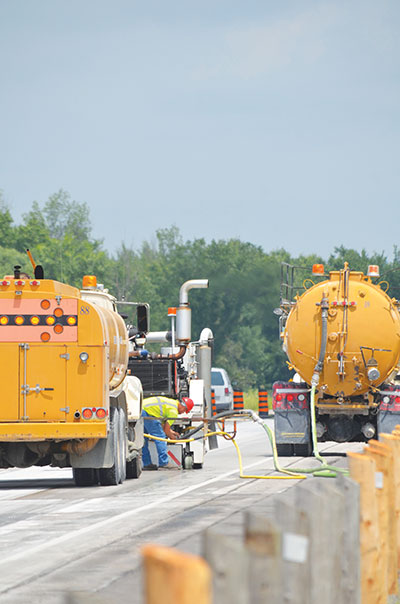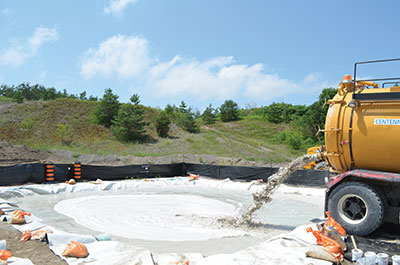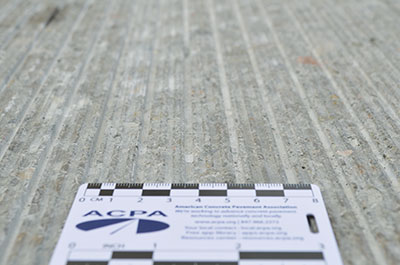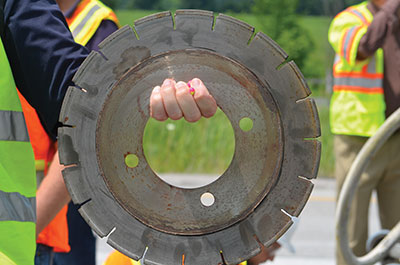
Features
Projects
Roads & Paving
Grooving and Grinding
Ontario looks at a new technique to improve concrete highways
November 27, 2014 By Andrew Macklin
Concrete Pavement Preservation techniques are not new in Canada and the
U.S. It has been almost 50 years since grooving and grinding was first
demonstrated on concrete roads in California in 1965.
Concrete Pavement Preservation techniques are not new in Canada and the U.S. It has been almost 50 years since grooving and grinding was first demonstrated on concrete roads in California in 1965. But in Canada, provincial transportation ministries have started to appreciate the inherent value of using this technique to extend the life of concrete highways.
 |
|
| The grooving and grinding process involves cutting, vacuuming and cleaning tools in order to take all excess materials off the road to provide the best possible end surface.
|
What it involves
Diamond Grinding involves the removal of the thin surface layer of hardened concrete using diamond saw blades. The removal of that layer helps to improve surface friction and blend together surface irregularities without affecting overhead clearances. The grinding process can be done in off-peak hours and is environmentally friendly.
Ultimately, the process provides an estimated 60%-70% improvement over the pre-grind profile of the road.
Diamond Grooving is used to help provide stronger water dispersal on concrete and asphalt roads. Groover blades are spread farther apart that grinding blades to provide relief for water to escape, similar to that of the commercial tire industry. The groover blades can be oriented in either a longitudinal or transverse orientation depending on user preference.
The residue left by both the grinding and grooving processes is slurry. All production grinders have a standard CGR vacuum as part of the operation. The slurry is vacuumed off of the roads and taken to nearby settling ponds where the sentiment can be separated, dried and recycled and the water re-used.
The result of using diamond grinding is a significant reduction in splash and spray, hydroplaning and wet weather accidents by up to 70 per cent according to data from the International Grooving & Grinding Association (IGGA).
Technique in action
From 1989 to 1991, the Ontario Ministry of Transportation (MTO) placed concrete pavements for Highway 115 under freeway twinning projects. The twinning project involved approximately 27 two-lane kilometres of concrete pavement. The 56.7km highway runs north/south, linking the city of Peterborough to Toronto via Highway 401.
 |
|
| The mix of water and fine aggregate that remains from the grooving process is dumped in a nearby settling pond, allowing the water to be reused later in the process. |
According to information provided by MTO: “While minor maintenance had occurred, the first major intervention after this was in 2007 by way of a Concrete Pavement Restoration (CPR) Contract which included full and partial depth slab repairs, selected crack sealing and stitching and dowel bar retrofit. This contract was followed by similar CPR contracts in 2008, 2009, and 2010.
“In 2011, a Contract was let for Diamond Grinding all concrete pavements on Highway 115. This process removed the remnants of the original transverse grooved (tined) surface and placed a regular longitudinal corduroy texture.
“In June of 2013, the tender for Diamond Grooving of concrete pavements on Highway 115 was issued. The tender opening was August of 2013. The tender also included extensive resealing of concrete joints.”
The diamond grinding technique has been used on Ontario highways before, but grooving was a new concept for MTO. John Roberts, who is the Executive Director of the IGGA, originally pitched the idea of diamond grooving in combination with diamond grinding to the Ministry.
Bringing partners together
The IGGA has been the foremost authority on concrete pavement preservation, joining with the American Concrete Pavement Association to create “The IGGA/ACPA Concrete Pavement Preservation Partnership (IGGA/ACPA CP3), which now serves as the technical resource and industry representative in the development and marketing of optimized pavement surfaces, concrete pavement restoration and pavement preservation around the world.”
 |
|
| A close-up look at a section of Highway 115 that has just been grooved shows how the water is efficiently chanelled off the roadway for better traction in wet weather conditions. |
|
 |
|
| A close-up look at a groover blade like the one used in the diamond grooving on Highway 115.
|
On the equipment side, The Graff Company of Toronto recently formed a partnership with Safety Grinding and Grooving, a Penhall Company, to provide diamond grinding and grooving services for concrete roadways in and around the Greater Toronto Area. That provided a local partner that could work with a skilled paving contractor, in this case Miller Paving, to provide the necessary grinding and grooving work as part of the Highway 115 tender.
The project involved single-lane reductions rather than full-lane closures on Highway 115, of vital importance in road improvement on a primarily rural highway that connects two major centres. The grinding equipment performed 3×1.2 metre passes, typical for diamond grinding work.
According to MTO, solid results have been observed on the road: “Concrete grinding provides a major improvement in ride condition especially for concrete pavements experiencing joint faulting or slab warping. Grinding also provides an improvement in skid resistance – the longevity of this improvement is highly dependent on the aggregates present in the concrete and the grinding pattern used. Grinding also provides a significant reduction in noise compared to our standard transverse grooved (tined) surface.
“Concrete grooving as a ‘negative’ coarser pattern set into the ground surface is less prone to wearing down and is understood to provide a longer-lived improvement in skid resistance. U.S. Studies have shown significant improvements in accident occurrence for diamond grooved concrete surfaces including major improvements under hydroplaning conditions. Diamond grooving also generally provides a further reduction in noise over a diamond ground surface.
“The diamond grooving and grinding of Highway 115 is the first Next Generation Concrete Surface (NGCS) completed by MTO. The early success of the project, which was completed in the summer of 2014, could lead to additional diamond grinding and grooving projects on Ontario’s concrete highways.”
– With files from MTO
Print this page